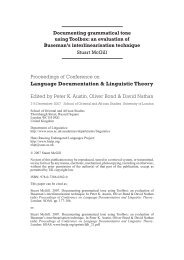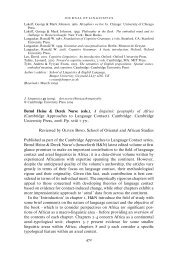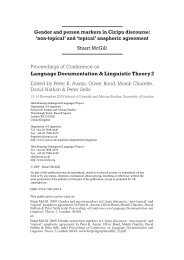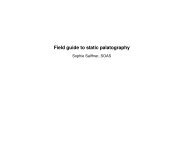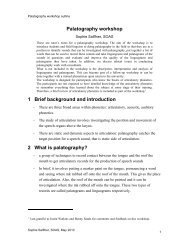Language Documentation & Linguistic Theory 2 - Hans Rausing ...
Language Documentation & Linguistic Theory 2 - Hans Rausing ...
Language Documentation & Linguistic Theory 2 - Hans Rausing ...
Create successful ePaper yourself
Turn your PDF publications into a flip-book with our unique Google optimized e-Paper software.
4. CORRELATIVE CLAUSES<br />
RENÉ LACROIX<br />
4.1. Areal data<br />
In correlative clauses, the domain noun generally appears inside the relative<br />
clause, which is left-dislocated. A typologically infrequent type of correlative<br />
clause is attested in colloquial Georgian. Consider, for instance, example (10).<br />
The domain noun kali ‘woman’ appears in the main clause; the relativization is<br />
marked by the subordinator rom, which is not restricted to relative clauses. Rom<br />
gives no clue as to which role is relativized.<br />
(10) xval rom naxavt,<br />
tomorrow SUB see.FUT.2PL<br />
is kali čveni axali mezobeli-a<br />
DIST.DEM woman POSS1PL new neighbor-COP<br />
‘The woman who you will see tomorrow is our new neighbor.’<br />
(Creissels 2005: 15)<br />
Correlative clauses appear sporadically in Turkish.<br />
4.2. Laz<br />
Laz attests free relatives using the correlative clause strategy. One example is<br />
given in (11). The left-dislocated constituent namu mogts’ondasen ‘the one you<br />
like’ is coreferent with the demonstrative pronoun heya in the main clause.<br />
(11) [namu mo-g-ts’ond-asen], heya e-č’op-i!<br />
INT/REL PV-II2-like-FUT.I3SG DIST.DEM PV-take-IMP<br />
‘Take the one you like!’ (lit. ‘which one you like, take it!’)<br />
(Žɣent’i 1938, text 27)<br />
The bracketed constituent functions as a free relative. No domain noun is stated.<br />
The interrogative/relative pronoun namu, which occurs in the position relativized,<br />
can be analyzed as a ‘domain noun substitute’ (see Creissels 2006: 208).<br />
5. CONCLUSION<br />
Almost all types of relativization strategies are attested in the Caucasus-Iran-<br />
Anatolia area. The important variation found in this domain correlates to some<br />
extent with genetic distribution. Broadly speaking, Turkic and North Caucasian<br />
languages, which mainly use prenominal participial relatives, contrast with Indo-<br />
European and South-Caucasian languages, where postnominal relatives headed by<br />
finite verb forms are common. From this point of view, Laz constitutes a<br />
particular case. Its major relativization strategy involves prenominal relative<br />
clauses headed by finite verb forms, a typologically infrequent type. This strategy<br />
209



